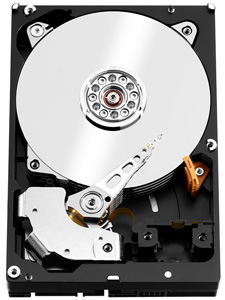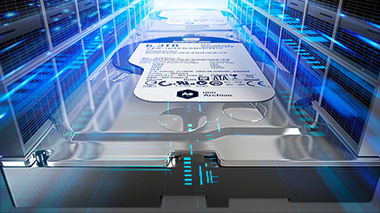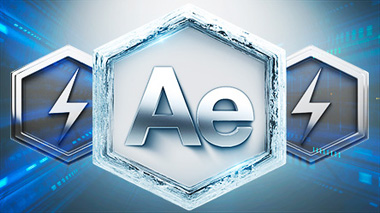
WD Ae 3.5-inch Hard Drives
Cost-Effective, Energy-Efficient HDD Cold-Storage Solution

Sorry, this product is no longer available, please contact us for a replacement.
Overview:
WD Ae delivers cost-effective, high-capacity, disk-layer storage for cold-data archive systems. These drives are built with features that address the unique requirements of cold-data archiving, including WD's innovative Progressive Capacity, an energy-efficient design, long lifecycle TCO and best-in-class dollars per gigabyte.

Over the last few years there has been a massive influx of information and data quantity which created what the industry views as a “new necessity.” This new necessity requires businesses to collect, have access to, and store data on a long-term basis. While it isn’t an entirely new problem, the rapid data growth in recent years has the spotlight focused on long-term data management.
How is all this newly accumulated data being stored, how frequently is it being accessed, and for how long can content creators have confidence that their personal and business data can be retrieved reliably? These are just a few of the questions surrounding “Cold Storage”.

So what exactly is cold storage? Put simply, it’s an affordable way to reliably store important yet infrequently accessed data for long periods of time. According to IDC, “cold storage is method operation of a data storage device or system for inactive data where an explicit trade-off is made, resulting in data retrieval response times beyond what may be considered normally acceptable to online or production applications in order to achieve significant capital and operational savings.” With consumer and business expectations changing, we must begin to examine this trade-off and determine who and what defines “acceptable performance” – a few seconds, minutes, more? This acceptable timeframe will vary from business to business, and even by application.

In order to address the new necessity to access cold data more efficiently and store ever increasing amounts of new data such as email, databases, and legal and accounting documents, etc., businesses must decide how they will store all this data. There are currently three primary options to handle storing all this data. Legacy Archiving (Tape), Virtual Tape Libraries (VTL), and Disk-based Archiving (HDD).

In order to address these new requirements to access archived data more efficiently and store ever increasing amounts of new data, such as email, databases, legal and accounting backups, etc., businesses must look at new storage alternatives built to meet these needs in a cost effective manner.
![]() Proven cold storage reliability
Proven cold storage reliability
With 700 PBs of cold storage deployed in datacenters already, WD's 4th generation WD Ae utilizes innovative technology to reduce power consumption and lower operating temperature, which results in a more reliable
and affordable solution for cold storage data archives.
Progressive Capacity
As technology and process mature over time in the manufacturing process incremental capacity increases are realized. WD's innovative Progressive Capacity model allows distribution of these incrementally higher capacity models taking advantage of their full capacity, 6.5 TB for instance.
Energy efficient
Reduced medial spin lowers power consumption and optimizes the drive's read/write ratio for the rigid requirements of cold storage systems.
Cost-effective capacity storage
Moving cold data to value optimized archive media delivers significant TCO savings by freeing up expensive performance-critical storage system capacity.
Cold data power management
Best-in-class power management, reduced heat output, and nextgeneration technologies such as IntelliSeek™ combine to deliver a balance of performance and power perfect for cold data archive storage architectures.
Quick to ready
Access time to cold data is quickly becoming a critical feature of an on-line archive system and end users can't wait days, weeks or months for this data to become available. The spin-down capability of WD Ae provides much faster access times than conventional archive tape with data access times of less than 20 seconds for on-demand data requests.
3D Active Balance™ Plus
Our enhanced dual-plane balance control technology significantly improves the overall drive performance and reliability. Hard drives that are not properly balanced may cause excessive vibration and noise in a multidrive system, reduce the hard drive life span, and degrade the performance over time.
NoTouch™ ramp load technology
The recording head never touches the disk media ensuring significantly less wear to the recording head and media as well as better drive protection in transit.
Dual actuator technology
A head positioning system with two actuators that improves positional accuracy over the data track(s). The primary actuator provides coarse displacement using conventional electromagnetic actuator principles. The secondary actuator uses piezoelectric motion to fine tune the head positioning to a higher degree of accuracy.
24x7 dedicated customer support
Every WD Ae hard drive comes with our world-class professional support services including a dedicated 24x7 support line (available in English, other regional support hours vary) and a 3-year limited warranty.
Ideal for:
The WD Ae is best suited for cold storage, backup and data archiving where data is stored on disk but rarely if almost never read again yet may be critical at some future point, prime examples being legal data or photo backups.
Features:

Energy efficient
Reduced medial spin lowers power consumption and optimizes the drive’s read/write ratio for the rigid requirements of cold storage systems.

Proven cold storage reliability
With 700 PBs of cold storage deployed in datacenters already, WD’s 4th generation WD Ae utilizes innovative technology to reduce power consumption and lower operating temperature, which results in a more reliable and affordable solution for cold storage data archives.

Cost-effective capacity storage
Moving cold data to value-optimized archive media delivers significant TCO savings by freeing up expensive performance-critical storage system capacity.

Progressive Capacity
As technology and manufacturing process mature over time the incremental capacity increases are realized. WD’s innovative Progressive Capacity model allows distribution of these incrementally higher capacity models taking advantage of their full capacity – 6.5TB for instance.

Quick Data Retrieval
Access time to cold data is quickly becoming a critical feature of an on-line archive system and end users can’t wait hours, days, or weeks for this data to become available. The spin-down capability of WD Ae provides much faster access times than conventional archive tape with data access times of less than 20 seconds for on-demand data requests.

Cold-data power management
Best-in-class power management, reduced heat output, and next-generation technologies such as IntelliSeek combine to deliver a balance of performance and power that is perfect for cold data archive storage architectures.
3D Active Balance Plus
Our enhanced dual-plane balance control technology significantly improves the overall drive performance and reliability. Hard drives that are not properly balanced may cause excessive vibration and noise in a multi-drive system, reduce the hard drive life span, and degrade the performance over time.
A head positioning system with two actuators that improves positional accuracy over the data track(s). The primary actuator provides coarse displacement using conventional electromagnetic actuator principles. The secondary actuator uses piezoelectric motion to fine tune the head positioning to a higher degree of accuracy.
NoTouch ramp load technology
The recording head never touches the disk media ensuring significantly less wear to the recording head and media as well as better drive protection in transit.
Every WD Ae hard drive comes with our world-class professional support services including a dedicated 24x7 support line (available in English, other regional support hours vary) and a 3-year limited warranty.
Specifications:
Examples of the number of photos, songs, videos and any other files that can be stored on a hard drive are provided for illustrative purposes only. Your results will vary based on file size and format, settings, features, software and other factors.
Photo: Figures represent the average number of photos taken with a 6 megapixel camera in high-resolution JPEG mode with an average file size of 3.5 MB per photo. The actual number of images will vary by camera model and compression setting.
Hours: The DV format, regardless of its mode (miniDV, DVCAM, DVC-Pro) has a data rate of approximately 25mb/s (mega-bits per second). In storage terms, this translates to approximately 3.5MB/s (Megabytes per second) or 13GB/hr (Gigabytes per hour)
Song: Music capacity is based on 4 minutes per song. MP3 capacity is based on 128 Kbps bit rate and 11:1 audio compression ratio. Uncompressed CD quality is based on 1:1 audio compression ratio.


As used for storage capacity, one megabyte (MB) = one million bytes, one gigabyte (GB) = one billion bytes, and one terabyte (TB) = one trillion bytes. Total accessible capacity varies depending on operating environment. As used for buffer or cache, one megabyte (MB) = 1,048,576 bytes. As used for transfer rate or interface, megabyte per second (MB/s) = one million bytes per second, megabit per second (Mb/s) = one million bits per second, and gigabit per second (Gb/s) = one billion bits per second.
| Model Number1 | WD6001F4PZ |
|---|---|
| Specifications | |
| Formatted Capacity2 | 11,721,045,168 |
| Interface | SATA 6 Gb/s |
| Form factor | 3.5-inch |
| Physical bytes per sector | 4096 |
| Host bytes per sector | 512 |
| RoHS Compliant3 | Yes |
| Performance | |
| Data transfer rate (max)2 Buffer to host host to/from drive (sustained) |
6 Gb/s >150 MB/s |
| Cache (MB) | 64 |
| Rotational Speed (RPM)3 | 5760 |
| Reliability/Data Integrity | |
| Load/unload cycles4 | 300,000 |
| Non-recoverable read errors per bits read | <1 in 1014 |
| MTBF (hours)5 | 500,000 |
| Limited warranty (years)6 | 3 |
| Power Management | |
| Average power requirements (W) Sequential read Sequential write Random read/write Idle |
6.4 6.5 4.9 4.8 |
| Environmental Specifications7 | |
| Operating Temperature | 10 to 55° C |
| Non-operating Temperature | -40 to 70° C |
| Shock (Gs) | |
| Operating (2 ms, read/write) | 30 |
| Operating (2 ms, read) | 65 |
| Non-operating (2 ms) | 300 |
| Acoustics (dBA)8 | |
| Idle | 25 |
| Seek (average) | 28 |
| Physical Dimensions | |
| Height (in./mm, max) | 1.028/26.1 |
| Length (in./mm, max) | 5.787/147 |
| Width (in./mm, ± .01 in.) | 4/101.6 |
| Weight (lb./kg, ± 3%) | 1.58/0.72 |
1 Not all products may be available in all regions of the world.
2 As used for storage capacity, one megabyte (MB) = one million bytes, one gigabyte (GB) = one billion bytes, and one terabyte (TB) = one trillion bytes. Total accessible capacity varies depending on operating environment. As used for buffer or cache, one megabyte (MB) = 1,048,576 bytes. As used for transfer rate or interface, megabyte per second (MB/s) = one million bytes per second, and gigabit per second (Gb/s) = one billion bits per second. Effective maximum SATA 3 Gb/s transfer rate calculated according to the Serial ATA specification published by the SATA-IO organization as of the date of this specification sheet. Visit www.sata-io.org for details.
3 WD hard drive products manufactured and sold worldwide after June 8, 2011, meet or exceed Restriction of Hazardous Substances (RoHS) compliance requirements as mandated by the RoHS Directive 2011/65/EU.
4 Controlled unload at ambient condition.
5 Product MTBF and AFR specifications are based upon a 40°C base casting and system workloads of up to 60 TB/year (workload is defined as the amount of user data transferred to or from the hard drive).
6 See http://support.wd.com/warranty for regional specific warranty details.
7 No non-recoverable errors during operating tests or after non-operating tests.
8 Sound power level.
Drive Views:

Bottom View

Top Angle View

Right Angle View

Cover View
Documentation:
Download the WD Ae Specsheet (PDF).
